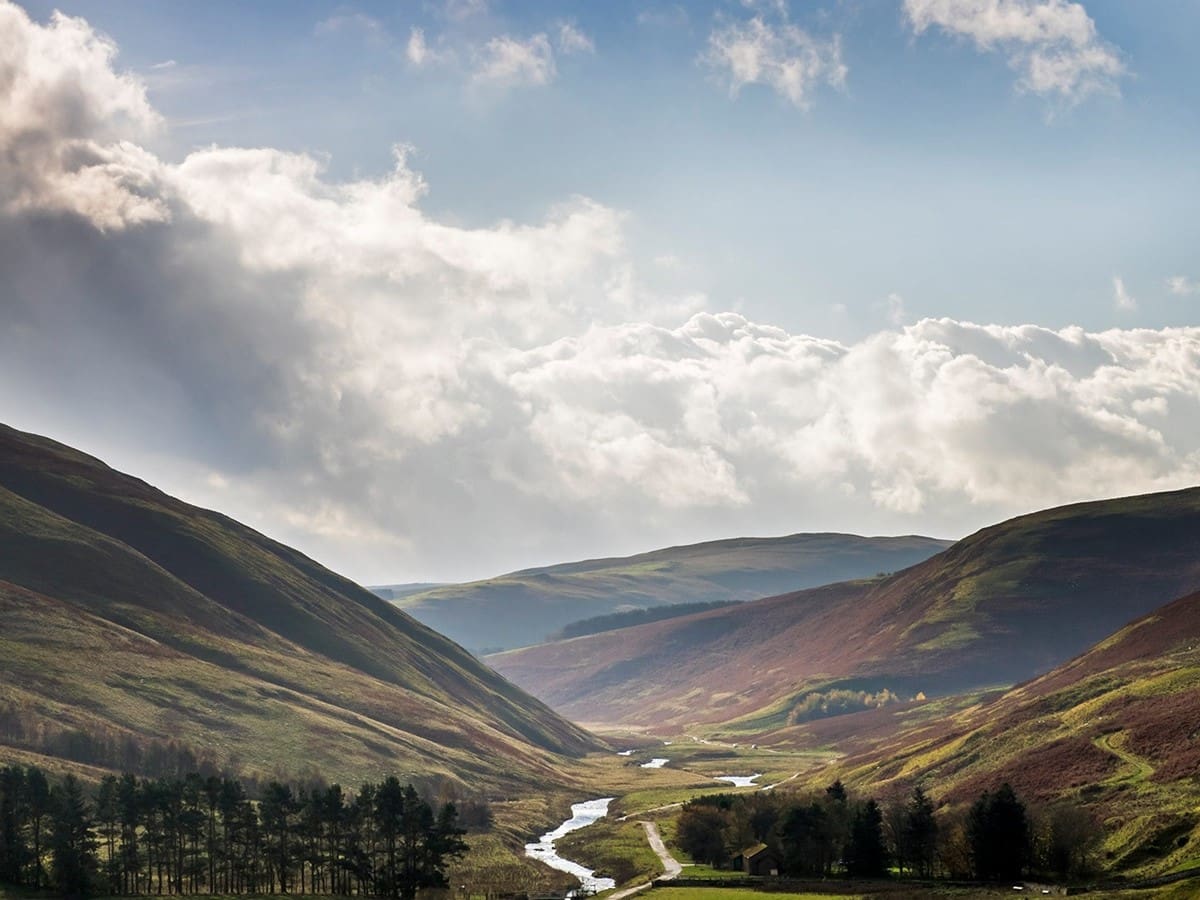2024 is a big year for the UK’s National Parks. They celebrate their 75th anniversary. However, amid this milestone a concerning report has been released showing that their future is not at all secure.
National Parks: under threat
This year sees the 75th anniversary of the National Parks and Access to the Countryside Act. These iconic landscapes contain a vast array of precious habitats and wildlife, and should, in theory, be the most highly protected and healthy parts of our natural environment.
But Campaign for National Parks’ health check, carried out across Wales and England, has discovered that nature is struggling for survival across a range of issues, including habitats, species, water quality, and wildlife crime.
- Only 19% of lakes in Wales’ three national Parks achieved good overall status in 2021 and only 44% of the rivers.
- Less than a quarter, 23% of Sites of Specific Scientific Interest (SSSIs) in National Parks in Wales are in a favourable state for nature.
- In 2022 the amount of sewage released from storm overflows within the boundaries of National Parks in England and Wales totalled 7,367 days. The National Parks most badly affected (according to hours of spills) are Dartmoor, Eryri, Lake District, South Downs and the Yorkshire Dales.
- Wales’ three National Parks have the potential to hold 29,431,000 tonnes of carbon content, the equivalent of three times Wales’ total CO2 annual emissions. But in 2019 the Welsh Government estimated that over 70% of Welsh peatlands were degraded.
This poor state of nature is due to a lack of resources, a lack of data and a lack of significant powers to make the systemic change needed.
Campaigning for National Parks
That’s why Campaign for National Parks with the support of Cymdeithas Eryri Snowdonia Society, the Friends of the Brecon Beacons National Park, and the Friends of the Pembrokeshire Coast National Park are calling for urgent action to halt and reverse these declines so National Parks can properly contribute to the UK’s efforts in tackling the nature and climate crisis.
The report does, however, include a number of very positive case studies of where National Park Authorities are supporting the successful projects which are helping restore habitats within National Parks in Wales.
One of these is Ffermwyr yr Wnion in Eryri. This is a group of ten farms within the Afon Wnion catchment. The project aims to collaboratively address local issues of flood risk and water quality as well as looking to bring benefits to biodiversity, pollinators, and air quality, whilst also helping tackle climate change.
Numerous pools and ponds have been created across the holdings as well as 7,725m hedgerows helping to prevent soil erosion and stop sediment and organic material from reaching the streams and rivers, thus improving water quality.
‘Nature is in crisis’
Iolo Williams, naturalist, wildlife TV presenter, writer and conservationist, said:
The National Parks of Wales hold a very special place in my heart. Having lived, worked and filmed amongst them for many years I have lost count of the endless hours spent tracking, admiring and promoting the special qualities and unique species present within them. From the rare Snowdon Lily in Eryri, to the choughs, puffins and stonechat of Pembrokeshire Coast, these treasured landscapes play host to a glorious array of diverse species.
But despite their protected status, nature is still in crisis across our National Parks. One in six species is at risk of disappearing from Wales so we must do everything within our power to protect and enhance wild spaces for wildlife to thrive. Campaign for National Parks have clearly set out a programme for action and we must stand together to get Governments in Westminster and the Senedd to act.
Major reforms for National Parks needed
Ruth Bradshaw, policy and research manager at Campaign for National Parks and author of the Health Check, said:
Our National Parks are special places which are often the last refuge for many species on the brink of extinction, but our Health Check has found that, even in these incredible places, nature is in crisis. The main causes of this crisis are the limited ability to influence what happens on most land in National Parks, particularly where it is privately owned, outdated legislation designed for a very different era, and the fact that the funding available just doesn’t match the national role that National Parks are expected to deliver for nature recovery.
It was far harder than it should have been for us to gather the evidence needed to understand the state of nature in National Parks, something which could be put right very easily, and which should be addressed as a matter of urgency. The scale of the challenges we’ve identified also demands a series of major reforms aimed at transforming the way these areas are run to ensure that there is much greater emphasis on nature recovery in all the decision-making relating to them.
Working for a brighter future
Megan McCubbin, zoologist, wildlife TV presenter, conservationist, photographer, and author, said:
Having grown up in the New Forest and enjoyed so many amazing experiences in our National Parks I know how important these unique landscapes are for wildlife, habitats and the people who cherish them. But beneath the picturesque exterior things aren’t looking quite so healthy. The sad truth is that the UK is one of the most nature-depleted countries in the world and National Parks need to be doing even more in the nature recovery fightback.
Working together we can help create National Parks that are nature-rich and climate-resilient, and in doing so offer a brighter future for the planet and all those who call it home. And that’s why Campaign for National Parks’ suggested reforms in this report are so important. There are some clear steps which Government can take to help National Parks thrive, but we must act now.
The National Parks Nature Health Check can be found here.
Welsh language version
Eleni mae 75 mlynedd ers Deddf Parciau Cenedlaethol a Mynediad i Gefn Gwlad. Mae’r tirweddau eiconig hyn yn cynnwys amrywiaeth eang o gynefinoedd a bywyd gwyllt gwerthfawr, a dylent, mewn egwyddor, fod y rhannau mwyaf gwarchodedig ac iach o’n hamgylchedd naturiol. Ond mae gwiriad iechyd yr Ymgyrch dros Barciau Cenedlaethol, a gynhaliwyd ledled Cymru a Lloegr, wedi darganfod bod byd natur yn brwydro i oroesi ar draws ystod o faterion, gan gynnwys cynefinoedd, rhywogaethau, ansawdd dŵr a throseddau bywyd gwyllt.
- Dim ond 19% o lynnoedd tri Pharc Cenedlaethol Cymru a gyrhaeddod statws cyffredinol da yn 2021 a dim ond 44% o’r afonydd1
- Mae llai na chwarter, sef 23% o Safleoedd o Ddiddordeb Gwyddonol Penodol (SoDdGA) Parciau Cenedlaethol yng Nghymru mewn cyflwr ffafriol i natur
- Yn 2022 rhyddhawyd cyfanswm o 7,367 o ddiwrnodau o garthffosiaeth o orlifiadau storm o fewn ffiniau Parciau Cenedlaethol Cymru a Lloegr. Y Parciau Cenedlaethol yr effeithir arnynt waethaf (yn ôl oriau o ollyngiadau) yw Dartmoor, Eryri, Ardal y Llynnoedd, South Downs a’r Yorkshire Dales.
- Mae gan dri Pharc Cenedlaethol Cymru y potensial i ddal 29,431,000 o dunelli o garbon, sy’n cyfateb i deirgwaith cyfanswm allyriadau CO2 Cymru.2 Ond yn 2019 amcangyfrifodd Llywodraeth Cymru fod dros 70% o fawndiroedd Cymru wedi’u diraddio.
Mae’r cyflwr natur gwael hwn yn ganlyniad i ddiffyg adnoddau, diffyg data a diffyg pwerau sylweddol i wneud y newidiadau systemig sydd ei angen. Dyna pam mae Ymgyrch y Parciau Cenedlaethol gyda chefnogaeth Cymdeithas Eryri, Cyfeillion Parc Cenedlaethol Bannau Brycheiniog a Chyfeillion Parc Cenedlaethol Arfordir Penfro yn galw am weithredu ar brys i atal a gwrthdroi’r gostyngiadau hyn fel y gall Parciau Cenedlaethol gyfrannu’n briodol at ymdrechion Gwledydd Prydain i fynd i’r afael â’r argyfwng natur a hinsawdd.
Fodd bynnag, mae’r adroddiad yn cynnwys nifer o astudiaethau achos cadarnhaol iawn o ble mae Awdurdodau Parciau Cenedlaethol yn cefnogi’r prosiectau llwyddiannus sy’n helpu i adfer cynefinoedd o fewn Parciau Cenedlaethol yng Nghymru. Un o’r rhain yw Ffermwyr yr Wnion yn Eryri. Grŵp o ddeg fferm yw hwn o fewn dalgylch Afon Wnion. Nod y prosiect yw mynd i’r afael ar y cyd â materion lleol sy’n ymwneud â pherygl llifogydd ac ansawdd dŵr yn ogystal â cheisio dod â buddion i fioamrywiaeth, pryfed peillio, ac ansawdd aer, tra’n helpu i fynd i’r afael â newid yn yr hinsawdd hefyd. Mae nifer o byllau a phyllau wedi’u creu ar draws y ffermydd yn ogystal â 7,725m o wrychoedd gan helpu i atal erydiad y pridd ac atal gwaddod a deunydd organig rhag cyrraedd y nentydd a’r afonydd, gan wella ansawdd dŵr.
Iolo Williams (Naturiwr, Cyflwynydd Teledu Bywyd Gwyllt, Awdur a Chadwraeth):
Mae gan Barciau Cenedlaethol Cymru le arbennig iawn yn fy nghalon. Ar ôl byw, gweithio a ffilmio ynddyn nhw ers blynyddoedd lawer, rwyf wedi colli cyfrif o’r oriau diddiwedd a dreuliwyd yn olrhain, edmygu a hyrwyddo’r rhinweddau arbennig a’r rhywogaethau unigryw sy’n ffynnu ynddynt. O Lili’r Wyddfa brin yn Eryri, i frain coesgoch, palod a clochdar y cerrig ar Arfordir Penfro, mae’r tirweddau gwerthfawr hyn yn gartref i amrywiaeth godidog o rywogaethau amrywiol.
Ond er gwaethaf eu statws gwarchodedig, mae byd natur yn dal mewn argyfwng ar draws ein Parciau Cenedlaethol. Mae un o bob chwe rhywogaeth mewn perygl o ddiflannu o Gymru felly mae’n rhaid i ni wneud popeth o fewn ein gallu i warchod a gwella mannau gwyllt er mwyn i fywyd gwyllt ffynnu. Mae’r Ymgyrch y Parciau Cenedlaethol wedi amlinelli rhaglen weithredu a rhaid inni sefyll gyda’n gilydd i gael Llywodraethau yn San Steffan a’r Senedd i weithredu.
Ruth Bradshaw (Rheolwr Polisi ac Ymchwil, Ymgyrch y Parciau Cenedlaethol, ac awdur yr Arolwg Iechyd):
Mae ein Parciau Cenedlaethol yn lleoedd arbennig sydd yn aml yn lloches olaf i lawer o rywogaethau sydd ar fin diflannu, ond mae ein Harolwg Iechyd wedi canfod, hyd yn oed yn y mannau anhygoel hyn, fod byd natur mewn argyfwng. Prif achosion yr argyfwng hwn yw’r gallu cyfyngedig i ddylanwadu ar yr hyn sy’n digwydd ar y rhan fwyaf o dir mewn Parciau Cenedlaethol, yn enwedig pan fydd o mewn dwylo preifat, hen ddeddfwriaeth a ddyfeisiwyd ar gyfer cyfnod gwahanol iawn, a’r ffaith nad yw’r cyllid sydd ar gael yn cyfateb i bwysigrwydd y rôl genedlaethol y disgwylir i Barciau Cenedlaethol ei chyflawni ar gyfer adferiad byd natur.
Yr oedd yn llawer anoddach nag y dylai hi fod inni gasglu’r dystiolaeth angenrheidiol i ddeall cyflwr natur mewn Parciau Cenedlaethol, rhywbeth y gellid ei ddatrys yn hawdd iawn, ac y dylid mynd i’r afael ag ef ar fyrder. Mae maint yr heriau rydym wedi’u nodi hefyd yn gofyn am gyfres o ddiwygiadau mawr gyda’r nod o drawsnewid y ffordd y caiff y meysydd hyn eu rhedeg er mwyn sicrhau bod llawer mwy o bwyslais ar adferiad byd natur yn yr holl benderfyniadau sy’n ymwneud â nhw.
Megan McCubbin (Sŵolegydd, Cyflwynydd Teledu Bywyd Gwyllt, Cadwraethydd, Ffotograffydd ac Awdur):
Ar ôl cael fy magu yn y New Forest a mwynhau cymaint o brofiadau anhygoel yn ein Parciau Cenedlaethol, fe wn i pa mor bwysig yw’r tirweddau unigryw hyn i fywyd gwyllt, cynefinoedd a’r bobl sy’n eu caru. Ond os edrychwch chi’n o dan yr wyneb hardd, nid yw pethau’n edrych mor iach. Y gwir trist yw bod y DU yn un o’r gwledydd y byd lle mae natur wedi dirywio fwyaf ac mae angen i Barciau Cenedlaethol wneud hyd yn oed mwy i frwydro yn ôl ac adfer byd natur.
Gan weithio gyda’n gilydd gallwn helpu i greu Parciau Cenedlaethol sy’n gyfoethog o ran natur ac sy’n gallu gwrthsefyll newid yr hinsawdd, a thrwy wneud hynny cynnig dyfodol mwy disglair i’r blaned a phawb sy’n byw arni. A dyna pam mae’r diwygiadau y mae Ymgyrch y Parciau Cenedlaethol yn galw amdanynt yn yr adroddiad hwn mor bwysig. Mae rhai camau clir y gall y Llywodraeth eu cymryd i helpu Parciau Cenedlaethol i ffynnu, ond rhaid i ni weithredu nawr.
Featured image via National Parks




